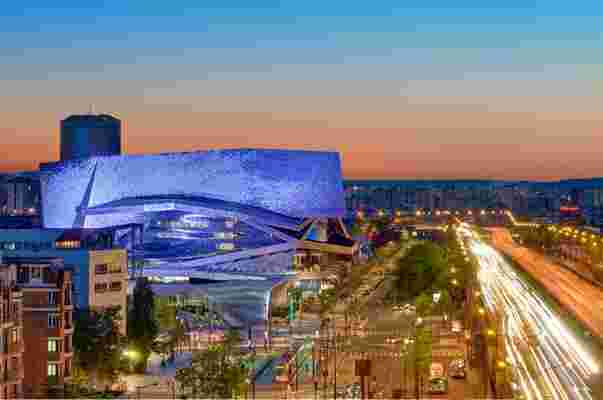Meet the Award-Winning Writer Who Just Made a Documentary About Jean Nouvel
Award-winning writer and filmmaker Matt Tyrnauer is fascinated with process.
It’s a fascination that’s evident throughout much of his work, from his many Vanity Fair pieces and profiles to his documentaries, among them the 2008 feature Valentino: The Last Empire, an intimate portrait of the esteemed haute couturier that went on to become one of the highest-grossing documentaries of 2010.
Keeping with the theme is his latest film, Jean Nouvel: Reflections, a stunning, pensive study in process. Running just 15 minutes, the documentary chronicles the career of renowned Pritzker Prize–winning French architect Jean Nouvel through the lens of his associates, his work—the Institut du Monde Arabe in Paris, the Doha Tower and the National Museum of Qatar, the Louvre Abu Dhabi, New York City’s 53W53—and the master himself, capturing him in various stages of his methodical design process.
For Tyrnauer, any opportunity to get inside an artist’s mind makes for a compelling narrative. Architectural Digest caught up with the filmmaker, a self-proclaimed “architecture groupie,” at the celebration of the film's world premiere at the New York Film Festival this past week to discuss the new documentary and his love for architecture, process, and Jean Nouvel.

Jean Nouvel’s Philharmonie de Paris, a cultural institution that was opened in January 2015.
Architectural Digest: Why did you decide to make a documentary about Jean Nouvel?
Matt Tyrnauer: I’d never made a pure architecture film before. I think Jean is a master who is about to hit that moment when architects cross over from being stars to superstars and potentially immortal superstars. The Louvre Abu Dhabi is a building that will be the level of Frank Gehry’s Guggenheim Bilbao. I think it’s going to be the Bilbao of the next generation. The opportunity to follow him and look at his process on the eve of the Louvre opening was an irresistible temptation for me.
AD: What did you learn about the architect and his process during the making of the film?
MT: I saw how contemplative he is. When you’re at that level and you’re running a global firm and you’re one ofthe few masters, you’re really a conceptualist. One of the things I was delighted to discover was that Jean, after he wakes up in the morning, goes back to bed and he visualizes. And that’s where he really conceptualizes and designs. I was amazed to hear that that’s the departure point for his process. He has this ritual where he gets in bed, pulls the cover over his head, puts an eyeshade on, and then thinks and visualizes. That is the beginning of the master at work.
AD: What was the first Nouvel structure you recall seeing?
MT: The Arab Institute [in Paris]. I went to see it when I was in college. It was the 1990s, so it wasn’t that old, and I went specifically to see it. That was my architecture-nerd period, and I thought it was amazing—that’s where I found out who Jean Nouvel was.
AD: In the film Nouvel discusses the importance of framing—in cinema, photography, architecture—and he’s known for using light in big ways in his works. Did that influence the way you approached the film? Did you feel you had to live up to a certain expectation, knowing Nouvel’s eye and level of awareness and precision for lighting, visual impact, framing, etc.?
MT: I felt there was pressure because obviously we’re dealing with a perfectionist who makes visual objects, and I was sure he would care about how we showed them. So the most important decision in making the film was how we were going to photograph the buildings. I decided to do a kind of rather basic but elegant photography that was not too fancy. I thought it would be good to do something that was tantamount to Ezra Stohler on film, capturing [the buildings] in an almost still-photography way but with slight movement and more life. It’s supposed to be quiet, not flashy, just letting the buildings speak for themselves. Also, Jean’s works are very graphic, so there was a real opportunity if the camera wasn’t moving around too much to appreciate their graphicness. And light was the next most important thing. His buildings are light machines so capturing that with the camera was important.
AD: At one point in the film, Nouvel quips, “Architects are strange people—strange animals.” As a writer and ardent follower of architecture, do you share his assessment?
MT: Yeah, they are. Architecture is an art, so you’re dealing with artists. But it’s art you live in, so it’s unique. It’s this very peculiar thing. Architects have a huge responsibility, much greater I think than all other artists in a lot of ways because . . . well, they can kill you, first of all! [ laughs ] They need to accommodate you in a way that other art doesn’t need to. I think the pressure of being that kind of artist creates a very peculiar, strange animal, as Jean says. I think a lot of it comes from that.
Watch Tyrnauer’s marvelously made 15-minute documentary.
This content can also be viewed on the site it originates from.